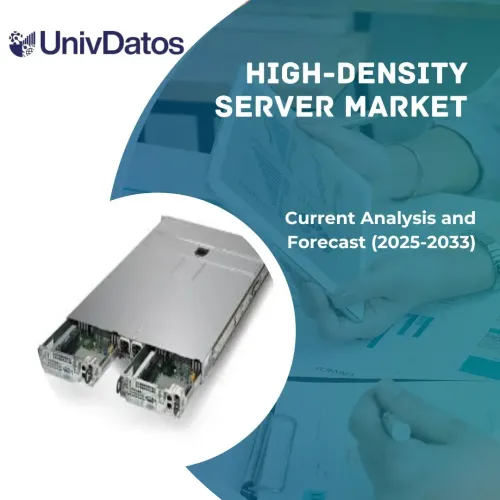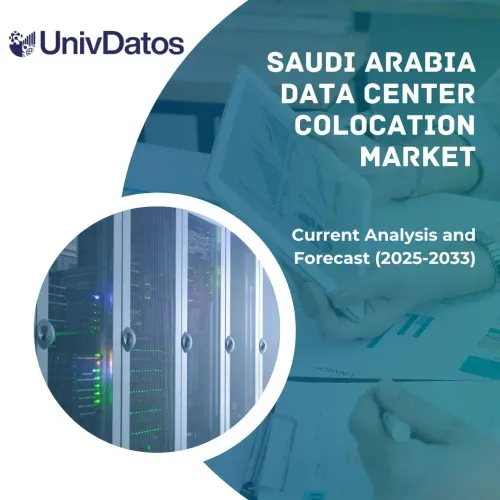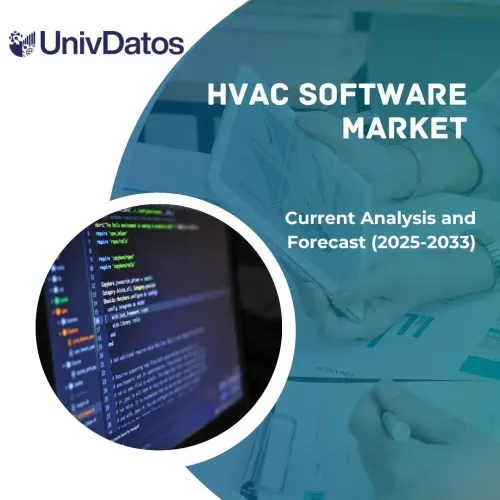- Startseite
- Über uns
- Industrie
- Dienstleistungen
- Lesen
- Kontaktieren Sie uns
Markt für intelligente Plantagenmanagementsysteme: Aktuelle Analyse und Prognose (2021-2027)
Schwerpunkt auf Typ (Bewässerungssysteme, Pflanzenwachstumsüberwachungssysteme und Erntesysteme); Kulturpflanze (Kaffee, Ölsaaten, Zuckerrohr, Baumwolle, Früchte, Sonstige); Komponente (Hardware, Software); Region/Land
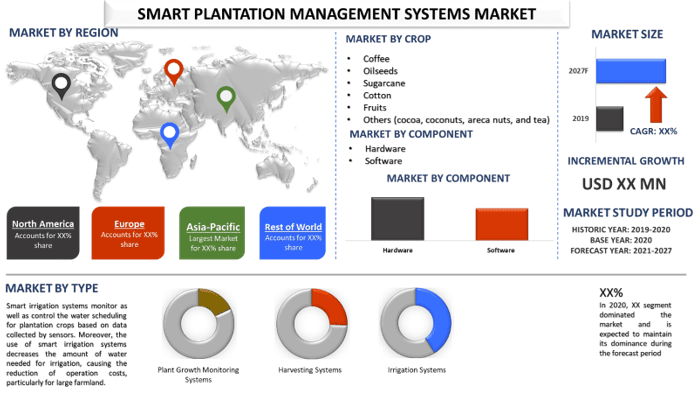
Der Markt für intelligente Plantagenmanagementsysteme lag im Jahr 2020 bei rund 1,168 Milliarden US-Dollar und wird voraussichtlich eine deutliche durchschnittliche jährliche Wachstumsrate (CAGR) von rund 6,4 % während des Prognosezeitraums aufweisen. Intelligente Plantagenmanagementsysteme überwachen den Zustand der Pflanzen, die Temperatur, die Bodenfeuchtigkeit und die Lichtintensität. Intelligente Bewässerungssteuerungssysteme helfen beispielsweise bei der Regulierung der Wasserversorgung auf der Grundlage von Daten, die von ihren Bodenfeuchtigkeitssensoren erfasst werden. Sie verursachen Warnmeldungen und Benachrichtigungen für Landwirte und helfen ihnen bei der Überwachung und Verfolgung der Pflanzengesundheit. Intelligente Plantagen können die Betriebskosten in den größeren Anbauflächen senken und Ernteausfälle verhindern. Die Nachfrage nach intelligenten Plantagenmanagementsystemen steigt aufgrund der zunehmenden Akzeptanz von Plantagenintelligenz (PI) und Data Mining durch Landwirte sowie der Verringerung der Ressourcen- und Personalverschwendung. Darüber hinaus wird erwartet, dass die zunehmende Akzeptanz von IoT-Technologie, Cloud Computing, landwirtschaftlichen Sensoren, maschinellem Lernen und intelligenten Bewässerungssystemen im Agrarsektor ein günstiges Umfeld für die intelligente Plantagenmanagement-Systemindustrie schaffen wird. Darüber hinaus boomt die wachsende Anzahl von intelligenten Plantagenmanagementsystemen, die über das Internet und die Cloud-Plattform miteinander verbunden sind, das Marktwachstum. Auch die Zuteilung von Tochtergesellschaften an Landwirte, die intelligente Anbautechniken einsetzen, und das wachsende Bewusstsein für diese Systeme werden sich im Prognosezeitraum voraussichtlich positiv auf den Markt auswirken. Darüber hinaus wird erwartet, dass die hohe Akzeptanz von 3D-Laserscanning, hyperspektraler Bildgebung und drohnenbasierten Bildgebungssensoren, die über Cloud-Plattformen miteinander verbunden sind, zu einer höheren Durchdringung der Plantagenintelligenz führen wird.
Globaler Anteil der künstlichen Intelligenz in der Landwirtschaft nach Anbautyp, 2019 & 2024
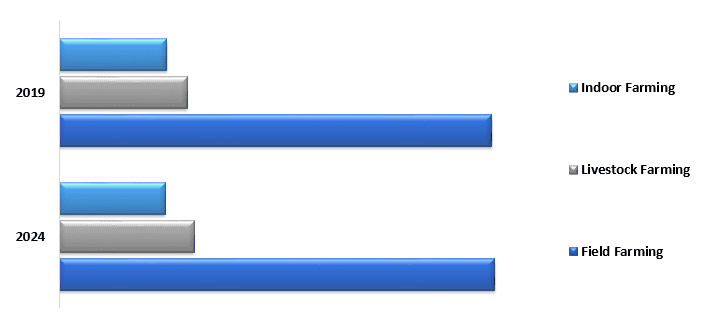
Im Bericht vorgestellte Einblicke
„Unter den Typen hält das Segment Bewässerungssysteme den größten Anteil.“
Basierend auf dem Typ ist der Markt in Bewässerungssysteme, Pflanzenwachstumsüberwachungssysteme und Erntesysteme unterteilt. Das Segment Bewässerungssysteme dominierte den Markt im Jahr 2020 und wird im prognostizierten Zeitraum voraussichtlich lukrativ wachsen. Intelligente Bewässerungssysteme überwachen und steuern die Wasserzuteilung für Plantagenkulturen auf der Grundlage von Daten, die von Sensoren erfasst werden. Darüber hinaus reduziert der Einsatz intelligenter Bewässerungssysteme die für die Bewässerung benötigte Wassermenge, was zu einer Senkung der Betriebskosten führt, insbesondere bei großen Ackerflächen. Gemäß den Tests des International Center for Water Technology (Kalifornien) und der Irrigation Association (IA) sparen intelligente Bewässerungssysteme rund 20 % mehr Wasser als herkömmliche Bewässerungssysteme, was die Nachfrage auf dem Markt ankurbelt. „Unter den Pflanzen hält das Segment Früchte den größten Anteil.“
Basierend auf den Pflanzen ist der Markt in Kaffee, Ölsaaten, Zuckerrohr, Baumwolle, Früchte und Sonstige (Kakao, Kokosnüsse, Betelnüsse und Tee) unterteilt. Das Segment Früchte dominierte den Markt im Jahr 2020 und wird im prognostizierten Zeitraum voraussichtlich lukrativ wachsen. In jüngster Zeit haben sich Früchte zu einer wichtigen Kulturpflanze für den Einsatz intelligenter Plantagenmanagementsysteme entwickelt, da eine große Anzahl von Akteuren intelligente Plantagensysteme für Früchte anbietet und Technologien für verschiedene Arten von Früchten entwickelt werden. Früchte wie Äpfel, Weintrauben und Zitrusfrüchte werden aufgrund ihres höheren Verbrauchs hauptsächlich für die Implementierung intelligenter Plantagenmanagementsysteme verwendet. Laut dem Agricultural Marketing Resource Center sind die am häufigsten konsumierten frischen Früchte in den USA Äpfel, Orangen, Weintrauben und Erdbeeren.
„Unter den Komponenten wird das Hardware-Segment im analysierten Zeitraum voraussichtlich die höchste CAGR aufweisen.“
Basierend auf den Komponenten ist der Markt in Hardware und Software unterteilt. Das Hardware-Segment hält im Jahr 2020 den größten Anteil und wird im kommenden Zeitraum voraussichtlich die höchste CAGR verzeichnen. Die Hardwarekomponente besteht aus mehreren Sensoren, GPS-Geräten, Controllern, Displays, Durchflussmessern, Schaltern und Magnetventilen. Sensoren werden entweder auf dem Boden oder auf den Pflanzen installiert, um Echtzeitdaten zu erfassen, die zur Erstellung von Berichten und Karten verwendet werden, um Landwirte bei Entscheidungen über ihre Pflanzen zu unterstützen. Verwendete Sensoren sind Boden, Wasser, Wetter, Feuchtigkeit, Windstärke und Temperatur, die hauptsächlich in der Pflanzenproduktion verwendet werden. Daher intensiviert der Fortschritt in Softwaresystemen das Wachstum von Hardwarekomponenten.
„Die Region Asien-Pazifik stellt einen der größten Märkte dar und wird voraussichtlich einer der am schnellsten wachsenden Märkte für intelligente Plantagenmanagementsysteme sein.“
Für ein besseres Verständnis der Marktakzeptanz von intelligenten Plantagenmanagementsystemen wird der Markt basierend auf seiner weltweiten Präsenz in den Ländern Nordamerika (Vereinigte Staaten, Kanada und das übrige Nordamerika), Europa (Deutschland, Frankreich, Spanien, Vereinigtes Königreich und das übrige Europa), Asien-Pazifik (China, Japan, Indien, Australien und das übrige Asien-Pazifik) und Rest der Welt analysiert. Die Region Asien-Pazifik wird den Markt für intelligente Plantagenmanagementsysteme aufgrund der zunehmend günstigen klimatischen Bedingungen für Plantagenkulturen dominieren. Aufgrund des großflächigen Anbaus verschiedener Plantagenkulturen wie Tee, Zuckerrohr und Baumwolle. Zu den wichtigsten Akteuren auf dem Markt gehören Robert Bosch, Deere & Company, Netafim, Synelixis Solutions, DTN, AgroWebLab Co., Ltd, SemiosBio Technologies, WaterBit und Phytech. Mehrere Fusionen und Übernahmen sowie Partnerschaften wurden von diesen Akteuren unternommen, um ihre Präsenz in verschiedenen Regionen zu stärken.
Gründe für den Kauf dieses Berichts:
- Die Studie umfasst Marktgrößen- und Prognoseanalysen, die von authentifizierten wichtigen Branchenexperten validiert wurden
- Der Bericht bietet einen schnellen Überblick über die Gesamtleistung der Branche auf einen Blick
- Der Bericht umfasst eine eingehende Analyse prominenter Branchenkollegen mit einem primären Fokus auf wichtige Finanzkennzahlen, Produktportfolio, Expansionsstrategien und aktuelle Entwicklungen
- Detaillierte Untersuchung von Treibern, Hemmnissen, wichtigen Trends und Chancen, die in der Branche vorherrschen
- Die Studie deckt den Markt umfassend über verschiedene Segmente hinweg ab
- Tiefgreifende regionale Analyse der Branche
Anpassungsoptionen:
Der Markt für intelligente Plantagenmanagementsysteme kann weiter an die Anforderungen oder jedes andere Marktsegment angepasst werden. Darüber hinaus versteht UMI, dass Sie möglicherweise Ihre eigenen geschäftlichen Anforderungen haben. Zögern Sie daher nicht, sich mit uns in Verbindung zu setzen, um einen Bericht zu erhalten, der vollständig Ihren Anforderungen entspricht.
Inhaltsverzeichnis
Die Analyse des historischen Marktes, die Schätzung des aktuellen Marktes und die Prognose des zukünftigen Marktes des globalen Smart Plantation Management Systems-Marktes waren die drei wichtigsten Schritte, die unternommen wurden, um die Einführung von Smart Plantation Management Systems für die verschiedenen Anwendungen in den wichtigsten Komponenten wie Hardware und Software zu erstellen und zu analysieren. Um die historischen Marktzahlen zu erfassen und die aktuelle Marktgröße zu schätzen, wurden umfassende Sekundärrecherchen durchgeführt. Zweitens wurden zahlreiche Erkenntnisse und Annahmen berücksichtigt, um diese Erkenntnisse zu validieren. Darüber hinaus wurden umfassende Primärinterviews mit Branchenexperten entlang der Wertschöpfungskette des Smart Plantation Management Systems-Sektors geführt. Nach der Annahme und Validierung der Marktzahlen durch Primärinterviews haben wir einen Top-Down-/Bottom-Up-Ansatz angewendet, um die vollständige Marktgröße zu prognostizieren. Danach wurden Methoden zur Marktaufschlüsselung und Datentriangulation angewendet, um die Marktgröße von Segmenten und Untersegmenten der Branche zu schätzen und zu analysieren.
Die detaillierte Methodik wird im Folgenden erläutert:
Analyse der historischen Marktgröße
Schritt 1: Eingehende Studie von Sekundärquellen:
Die detaillierte Sekundärstudie wurde durchgeführt, um die historische Marktgröße der Smart Plantation Management Systems anhand von unternehmensinternen Quellen wie Jahresberichten & Finanzberichten, Performance-Präsentationen, Pressemitteilungen usw. und externen Quellen wie Fachzeitschriften, Nachrichten & Artikeln, Regierungsveröffentlichungen, Wettbewerberveröffentlichungen, Sektorberichten, Datenbanken von Drittanbietern und anderen glaubwürdigen Veröffentlichungen zu erhalten.
Schritt 2: Marktsegmentierung:
Nachdem wir die historische Marktgröße des Smart Plantation Management Systems-Marktes erhalten hatten, führten wir eine detaillierte Sekundäranalyse durch, um historische Markteinblicke und Anteile für verschiedene Segmente für die wichtigsten Regionen zu sammeln. Zu den wichtigsten Segmenten, die im Bericht enthalten sind, gehören Typ, Anbau, Komponente und Region. Darüber hinaus wurden Länderanalysen durchgeführt, um die allgemeine Akzeptanz von Smart Plantation Management Systems in jeder Region zu bewerten.
Schritt 3: Faktorenanalyse:
Nachdem wir die historische Marktgröße verschiedener Segmente und Untersegmente ermittelt hatten, führten wir eine detaillierte Faktorenanalyse durch, um die aktuelle Marktgröße von Smart Plantation Management Systems zu schätzen. Darüber hinaus führten wir eine Faktorenanalyse mit abhängigen und unabhängigen Variablen wie dem steigenden Gesundheitsbewusstsein und der zunehmenden Alterung der Bevölkerung in Verbindung mit der hohen Prävalenz chronischer Krankheiten in verschiedenen Regionen durch.
Aktuelle Marktzufallsschätzung & Prognose
Aktuelle Marktgröße: Basierend auf den verwertbaren Erkenntnissen aus den oben genannten 3 Schritten gelangten wir zur aktuellen Marktgröße, den wichtigsten Akteuren auf dem Smart Plantation Management Systems-Markt und den Marktanteilen der Segmente. Alle erforderlichen prozentualen Anteile und Marktaufschlüsselungen wurden anhand des oben genannten Sekundäransatzes ermittelt und durch Primärinterviews verifiziert.
Schätzung & Prognose: Für die Marktschätzung und -prognose wurden verschiedenen Faktoren Gewichte zugewiesen, darunter Treiber & Trends, Einschränkungen und Chancen, die den Stakeholdern zur Verfügung stehen. Nach der Analyse dieser Faktoren wurden relevante Prognosetechniken, d. h. der Top-Down-/Bottom-Up-Ansatz, angewendet, um die Marktprognose für 2027 für verschiedene Segmente und Untersegmente in den wichtigsten Märkten weltweit zu erstellen. Die Forschungsmethodik, die zur Schätzung der Marktgröße angewendet wurde, umfasst:
- Die Marktgröße der Branche in Bezug auf den Wert (USD) und die Akzeptanzrate von Smart Plantation Management Systems in den wichtigsten Märkten im Inland
- Alle prozentualen Anteile, Aufteilungen und Aufschlüsselungen von Marktsegmenten und Untersegmenten
- Schlüsselakteure auf dem Smart Plantation Management Systems-Markt in Bezug auf die angebotenen Dienstleistungen. Außerdem die Wachstumsstrategien, die von diesen Akteuren angewendet werden, um in dem schnell wachsenden Markt zu konkurrieren.
Validierung der Marktgröße und des Marktanteils
Primärforschung: Es wurden ausführliche Interviews mit den Key Opinion Leaders (KOLs) geführt, darunter Führungskräfte der obersten Ebene (CXO/VPs, Vertriebsleiter, Marketingleiter, Betriebsleiter und Regionalleiter, Länderleiter usw.) in den wichtigsten Regionen. Die Ergebnisse der Primärforschung wurden dann zusammengefasst und eine statistische Analyse durchgeführt, um die aufgestellte Hypothese zu beweisen. Die Erkenntnisse aus der Primärforschung wurden mit den Sekundärergebnissen zusammengeführt, wodurch Informationen in verwertbare Erkenntnisse umgewandelt wurden.
Aufteilung der Primärteilnehmer in verschiedene Regionen
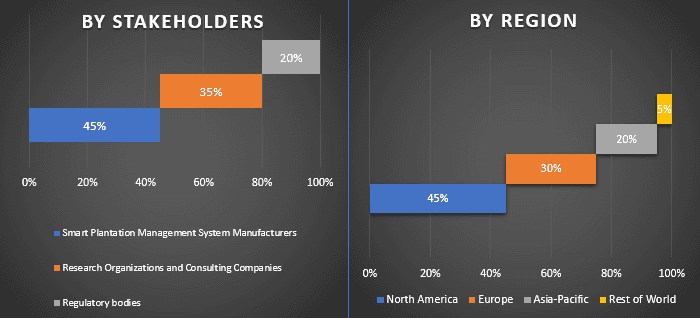
Markttechnik
Die Datentriangulationstechnik wurde angewendet, um die Gesamtmarktschätzung abzuschließen und genaue statistische Zahlen für jedes Segment und Untersegment des Smart Plantation Management Systems-Marktes zu erhalten. Die Daten wurden in mehrere Segmente & Untersegmente aufgeteilt, nachdem verschiedene Parameter und Trends in den Bereichen Typ, Anbau, Komponente und Region des Smart Plantation Management Systems-Marktes untersucht wurden.
Hauptziel der Smart Plantation Management Systems Marktstudie
Die aktuellen & zukünftigen Markttrends von Smart Plantation Management Systems wurden in der Studie genau bestimmt. Investoren können strategische Einblicke gewinnen, um ihre Entscheidungen für Investitionen auf der Grundlage der in der Studie durchgeführten qualitativen und quantitativen Analyse zu treffen. Die aktuellen und zukünftigen Markttrends haben die Gesamtattraktivität des Marktes auf regionaler Ebene bestimmt und eine Plattform für die industriellen Teilnehmer geschaffen, um den unerschlossenen Markt zu nutzen und von einem First-Mover-Vorteil zu profitieren. Weitere quantitative Ziele der Studien sind:
- Analyse der aktuellen und prognostizierten Marktgröße von Smart Plantation Management Systems in Bezug auf den Wert (USD). Analysieren Sie auch die aktuelle und prognostizierte Marktgröße verschiedener Segmente und Untersegmente.
- Die Segmente in der Studie umfassen die Bereiche Typ, Anbau, Komponente und Region
- Definition und Analyse des regulatorischen Rahmens für die Smart Plantation Management Systems-Branche
- Analyse der Wertschöpfungskette, an der verschiedene Vermittler beteiligt sind, sowie Analyse des Kunden- und Wettbewerberverhaltens der Branche
- Analyse der aktuellen und prognostizierten Marktgröße des Smart Plantation Management Systems-Marktes für die wichtigste Region
- Zu den wichtigsten Regionen, die im Bericht untersucht werden, gehören Nordamerika (die Vereinigten Staaten und Kanada), Europa (Deutschland, Frankreich, Spanien und das Vereinigte Königreich), der asiatisch-pazifische Raum (China, Japan, Indien und Australien) und der Rest der Welt
- Unternehmensprofile des Smart Plantation Management Systems-Marktes und die Wachstumsstrategien, die von den Marktakteuren angewendet werden, um sich in dem schnell wachsenden Markt zu behaupten
- Detaillierte regionale Analyse der Branche
Verwandt Berichte
Kunden, die diesen Artikel gekauft haben, kauften auch


